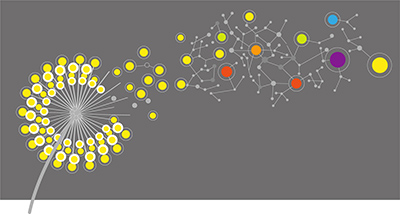By all accounts, Jake Wittig ’19 enjoyed a strong freshman season for the Rochester men’s basketball team last year. The point guard started 23 games and averaged 8.8 points and 3.3 assists.
Unlocking big data
A Newscenter series on how Rochester is using data science to change how we research, how we learn, and how we understand our world.
When the season ended, Wittig dug a little deeper to evaluate his performance. Using Synergy Sports Technology, an online service whose clients include hundreds of NCAA teams from Divisions I, II, and III, Wittig learned that he ranked “below average” in catch and shoot 3-pointers (19th percentile), jump shots off the dribble (31st percentile), and pick and roll including passes (48th percentile).
“The data showed me what I was good at and what I needed to work on,” says Wittig, a business major from Manlius, New York, and son of Jeff Wittig ’86, a two-time All-American quarterback at Rochester. “Last summer, I worked on those things and have been able to make better reads and limit my turnovers.”
Through the middle of February, Synergy ranked Wittig “very good” in catch and shoot (76th percentile) and jump shots off the dribble (79th percentile), and “excellent” for pick and roll including passes (88th percentile).
“The data made me a better player,” Wittig says.

Data analytics is the new normal for college teams. Programs pay for different web-based programs out of their annual budgets to evaluate student-athletes, plan for opponents, and even prevent injuries.
“Data has become essential for so many coaches,” Rochester men’s soccer coach Chris Apple ’92 says. Women’s lacrosse coach Sue Behme says she uses data “for almost everything we do.”
Dan Wesley ’94, Rochester’s head men’s golf coach since 2007, says life was much simpler when he played for the Yellowjackets.
“I’d come off the course and [then head coach] Don Smith would say, ‘What did you shoot?’” Wesley says. “I’d tell him, and he’d write it down. That’s it.”
These days, Wesley’s players tell him where each shot went. Using smartphones and tablets, they log into GolfStat, a performance diagnostics tool, and recreate their round: Drive went left. Fairway shot veered right. Ball landed in sand trap. Wedge shot missed green. Missed par putt. And so on.
“I get reports every two weeks during the season telling us what each player is averaging on pars 3s, 4s, and 5s, what percentage of fairways they’re hitting, what percentage of greens we’re hiting, and whether we are missing left, right, short, or long,” Wesley says.
Apple’s soccer team uses a data base called VidSwap, which allows players to study opponents’ attacking and defending tendencies as well as their own pass completions, turnovers, penalties created, and goals scored. By using FrontRush, Apple can track how often recruits are opening his emails. “It shows their level of interest,” he says.Sam Albert ’01, ’02W (MS), the University’s director of track and field, says “one of the greatest modern developments in our sport” was the creation of the Track & Field Results Reporting System (TFRRS) in 2010. It’s a national database which serves as a clearinghouse for all college track and cross country results. Schools are required to upload official results from every competition to the system.
“It’s available instantly and in real time,” Albert says. “Every college team and athlete has a profile in the TFRRS system, which allows convenient access to current data and performances and also has created a running archive of literally every competition and result.”
Football has by far the largest roster of any University team (76 last fall), making it virtually impossible for head coach Scott Greene and his staff to evaluate every player through data. The Yellowjackets subscribe to hudl, an online system that provides video review and performance analysis tools for teams and athletes at every level.
“We look at field position, down and distance, and personnel and formation to analyze what our best calls might be,” Greene says.
Field hockey coach Wendy Andreatta uses VidSwap to measure success with set pieces and to help improve shooting and save percentages. The data also shows where and how the Yellowjackets are scored upon.

Andreatta says having data keeps her players more open to tactical changes.
“What it does for our players is make them listen to their coaches a little bit more,” she says. “When we say this is a great scoring position, and we can have the data to back it up, they’ll put themselves in that scoring position more readily than they would if they hadn’t seen it.”
Men’s basketball coach Luke Flockerzi and women’s basketball coach Jim Scheible both use Synergy. That’s not just a choice; it’s a requirement of the University Athletic Association, which seeks to keep all teams on a level playing court.
The company Synergy—founded by Garrick Barr, a former coach with the NBA’s Phoenix Suns—has transformed the way coaches and general managers evaluate talent. Each year, the Seattle-based company analyzes and breaks down more than 50,000 games worldwide above the high school level.
Statistics are linked to videos, too. So if your point guard missed 18 shots last Sunday, player and coach can watch him or her missing those 18 shots.
“It used to take me two hours to watch an opponent’s game,” Flockerzi says. “Now I can watch it in 15 minutes, by eliminating timeouts, free throws, things like that. I can watch the parts I want to watch.”
“I’m definitely a fan of Synergy,” says Sam Borst-Smith ’17, a starting guard on the men’s basketball team and an English major from San Pedro, California. “The information shows what our collective team strengths are, as well as individual.”
At the same time, there are players and coaches who maintain that data analytics, for all its obvious uses and benefits, shouldn’t be seen as a substitute for instinct. Borst-Smith is among them.
“You can’t get too wrapped up in the statistics that Synergy provides,” he says. “Keeping your strengths and weaknesses in the back of your mind can result in negative effects, such as putting pressure on yourself to perform at a high level that will keep your statistics high. Once you’re able to not think about your statistics and just go out and perform, you’ll play better.”
There are a few University coaches who don’t subscribe to a web-based data analytics system. Men’s and women’s tennis coach Matt Nielsen relies on good old pencil and paper to track number of shots per point, percentage of points won on second serves, and percentage of points won at the net. Nielsen is looking into purchasing data apps for smartphones, which would allow his players easy access to pertinent information.
“Craig O’Shannessy, lead strategic analyst for the ATP tour, Wimbledon and Australian Open and founder of BrainGameTennis.com, came to campus in September to give a presentation,” Nielsen says. “He has analyzed data collected from thousands of tennis matches to determine the most effective strategies for winning at all levels. After seeing the data, I’ve dramatically changed the way our teams practice to focus on areas that have the biggest impact on winning.”
Squash coach Martin Heath also succeeds—really succeeds—without data.
He relies on “just old-fashioned scouting,” he says. “I get recruits to send me a link to a YouTube video of them playing a match and use my own analysis.”
Something’s working. The Yellowjackets are a perennial powerhouse. Last spring, they lost to Yale in the College Squash Association national championship, and earlier this year the Yellowjackets were ranked No. 1 in the nation.
For most sports, however, data science is here to stay. And it will continue to improve.
“What we have now is so much better than just a few years ago,” Flockerzi says. “I can’t imagine what’s in store in the years ahead.”





